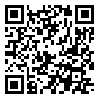Volume 12, Issue 47 (10-2003)
JGUMS 2003, 12(47): 80-85 |
Back to browse issues page
Download citation:
BibTeX | RIS | EndNote | Medlars | ProCite | Reference Manager | RefWorks
Send citation to:



BibTeX | RIS | EndNote | Medlars | ProCite | Reference Manager | RefWorks
Send citation to:
A Study on Prevalence of Horizontal Strabismus in Patients Under 14 Years . JGUMS 2003; 12 (47) :80-85
URL: http://journal.gums.ac.ir/article-1-729-en.html
URL: http://journal.gums.ac.ir/article-1-729-en.html
Abstract: (8042 Views)
Introduction: Prevalence of strabismus in general population is 5% and 90% of that is horizontal. Esotropia accounts for more than half of it. According to different etiology of strabismus that is treatable with simple glasses, association with amblyopia, cosmetic and functional compliance.
Objective: We tried to do a descriptive study about frequency of different types of horizontal strabismus.
Materials and Methods: In our descriptive study, patients with following criteria were selected: patients presenting to special clinic in Rasht with horizontal strabismus and under the age of 14 between 1999-2000 and in first quarter of Iranian year 1381 (2nd quarter of 2001). Eye examinations included central visual acuity, cycloplegic refraction with atropine eye drop 0.5% (every 8hours for 3 days), measurement of deviation in far (6meters), near (o.33 meter) with alternate prism & cover test and fundoscopy. If needed, glasses was prescribed and in some cases, surgery done. Then data were surveyed with a descriptive study model.
Results: Total cases were 291.Of all patients, 221 cases (76%) had esotropia and 70 cases (24%) exotropia. 56% of total cases, 57% of esotropia and 54% of exotropia are females and the rest are males. Female/male ratios in total cases of esotropia and exotropia are 1.31 and 1.16 respectively. The most common esotropia types are refractive accommodative (30%), partially accommodative (27.7%) & congenital (19.7%). The most common exotropia types are basic (47%), simulated divergence excess (17%) and sensory (12%). 11% of all cases had A, V pattern. 35% of esotropia and 25% of exotropia had amblyopia.
Conclusion: This study indicated that refractive accommodative esotropia is the most common type and wearing glasses at low ages can reduce the amount of deviation and amblyopia.
Review Paper: Research |
Subject:
Special
Received: 2014/09/17 | Accepted: 2014/09/17 | Published: 2014/09/17
Received: 2014/09/17 | Accepted: 2014/09/17 | Published: 2014/09/17
| Rights and permissions | |
 |
This work is licensed under a Creative Commons Attribution-NonCommercial 4.0 International License. |




